
Compost is a mixture of ingredients used as plant fertilizer and to improve soil's physical, chemical, and biological properties. It is commonly prepared by decomposing plant and food waste, recycling organic materials, and manure. The resulting mixture is rich in plant nutrients and beneficial organisms, such as bacteria, protozoa, nematodes, and fungi. Compost improves soil fertility in gardens, landscaping, horticulture, urban agriculture, and organic farming, reducing dependency on commercial chemical fertilizers. The benefits of compost include providing nutrients to crops as fertilizer, acting as a soil conditioner, increasing the humus or humic acid contents of the soil, and introducing beneficial microbes that help to suppress pathogens in the soil and reduce soil-borne diseases.

Hydroponics is a type of horticulture and a subset of hydroculture which involves growing plants, usually crops or medicinal plants, without soil, by using water-based mineral nutrient solutions in an artificial environment. Terrestrial or aquatic plants may grow freely with their roots exposed to the nutritious liquid or the roots may be mechanically supported by an inert medium such as perlite, gravel, or other substrates.

Vermicompost (vermi-compost) is the product of the decomposition process using various species of worms, usually red wigglers, white worms, and other earthworms, to create a mixture of decomposing vegetable or food waste, bedding materials, and vermicast. This process is called vermicomposting, with the rearing of worms for this purpose is called vermiculture.
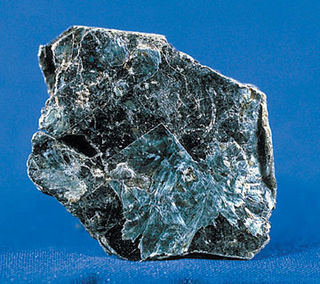
Vermiculite is a hydrous phyllosilicate mineral which undergoes significant expansion when heated. Exfoliation occurs when the mineral is heated sufficiently; commercial furnaces can routinely produce this effect. Vermiculite forms by the weathering or hydrothermal alteration of biotite or phlogopite. Large commercial vermiculite mines exist in the United States, Russia, South Africa, China, and Brazil.
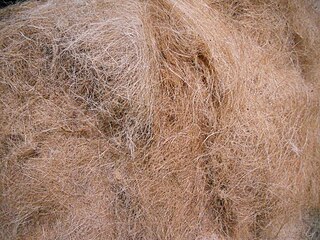
Coir, also called coconut fibre, is a natural fibre extracted from the outer husk of coconut, and used in products such as floor mats, doormats, brushes, and mattresses. Coir is the fibrous material found between the hard, internal shell and the outer coat of a coconut. Other uses of brown coir are in upholstery padding, sacking and horticulture. White coir, harvested from unripe coconuts, is used for making finer brushes, string, rope and fishing nets. It has the advantage of not sinking, so can be used in long lengths in deep water without the added weight dragging down boats and buoys.

A mulch is a layer of material applied to the surface of soil. Reasons for applying mulch include conservation of soil moisture, improving fertility and health of the soil, reducing weed growth, and enhancing the visual appeal of the area.

A houseplant, sometimes known as a pot plant, potted plant, or an indoor plant, is an ornamental plant that is grown indoors. As such, they are found in places like residences and offices, mainly for decorative purposes. Common houseplants are usually tropical or semi-tropical, and are often epiphytes, succulents or cacti.

A growbag is a planter filled with a growing medium and used for growing plants, usually tomatoes or other salad crops. Originally made of plastic, modern bags are also made from jute or fabric. The growing medium is usually based on a soilless organic material such as peat, coir, composted green waste, composted bark or composted wood chips, or a mixture of these. Various nutrients are added, sufficient for one season's growing, so frequently only planting and watering are required of the end-user. Planting is undertaken by first laying the bag flat on the floor or bench of the growing area, then cutting access holes in the uppermost surface, into which the plants are inserted.
A soil conditioner is a product which is added to soil to improve the soil’s physical qualities, usually its fertility and sometimes its mechanics. In general usage, the term "soil conditioner" is often thought of as a subset of the category soil amendments, which more often is understood to include a wide range of fertilizers and non-organic materials. In the context of construction soil conditioning is also called soil stabilization.
Passive hydroponics, semi-hydroponics or passive subirrigation is a method of growing plants without soil, peat moss, or bark.
This is an alphabetical index of articles related to gardening.

Agricultural soil science is a branch of soil science that deals with the study of edaphic conditions as they relate to the production of food and fiber. In this context, it is also a constituent of the field of agronomy and is thus also described as soil agronomy.

Ebb and flow hydroponics is a form of hydroponics that is known for its simplicity, reliability of operation and low initial investment cost. Pots are filled with an inert medium which does not function like soil or contribute nutrition to the plants but which anchors the roots and functions as a temporary reserve of water and solvent mineral nutrients. The hydroponic solution alternately floods the system and is allowed to ebb away.

Lightweight expanded clay aggregate (LECA) or expanded clay (exclay) is a lightweight aggregate made by heating clay to around 1,200 °C (2,190 °F) in a rotary kiln. The heating process causes gases trapped in the clay to expand, forming thousands of small bubbles and giving the material a porous structure. LECA has an approximately round or oblong shape due to circular movement in the kiln and is available in different sizes and densities. LECA is used to make lightweight concrete products and other uses.
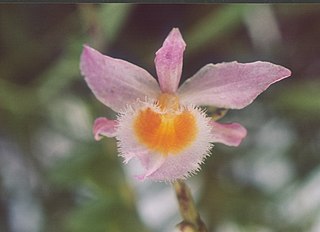
Dendrobium loddigesii is a miniature to small sized, warm to cold growing epiphyte, lithophyte or terrestrial orchid that comes from Laos, Vietnam, and China. It is found in humid, mossy, mixed and coniferous forests at elevations of 1000 to 1500 meters, in areas with dry winter and a wet spring and summer. The plant has tufted, pendant, subterete, striated, several-noded, white-sheathed stems carrying alternate, fleshy, oblong, acute leaves.
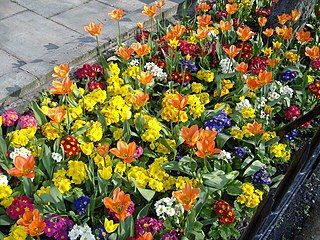
Many types of flowering plants are available to plant in flower gardens or flower beds. The floral industry calls these plants, bedding plants. These fast-growing plants in seasonal flower beds create colourful displays, during spring, summer, fall or winter, depending on the climate. Plants used for bedding are generally annuals, but biennials, tender perennials, and succulents are used.
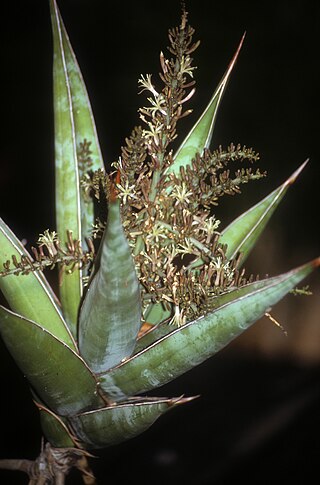
Dracaena pinguicula, synonym Sansevieria pinguicula, also known as the walking sansevieria, is a xerophytic CAM succulent native to the Bura area of Kenya, near Garissa. The species was described by Peter René Oscar Bally in 1943.
There are many ways to garden in restricted spaces. Often a small or limited space is an issue in growing and cultivating plants. Restricted space gardens can be located on small lawns, balconies, patios, porches, rooftops, inside the home, or in any other available place. Gardening in small places can be applied to edible or floral plants. Growing food has many benefits including saving money; healthier, fresher, and better tasting food; knowledge of pesticide and fertilizer exposure. Gardening is a good form of exercise and has been proven to be therapeutic.
Growstones are a substrate for growing plants that can be used for soilless purposes or as a soil conditioner. This substrate is made from recycled glass. It has both more air and water retention space than perlite and peat. Another property of this medium is that it holds more water than parboiled rice hulls. Growstones appear to be a comparable alternative to expanded clay aggregate.

Dracaena eilensis, synonym Sansevieria eilensis, is a species of succulent plant native to a small region of Somalia near the town of Eyl. The species was collected in 1973 by John Lavranos.















